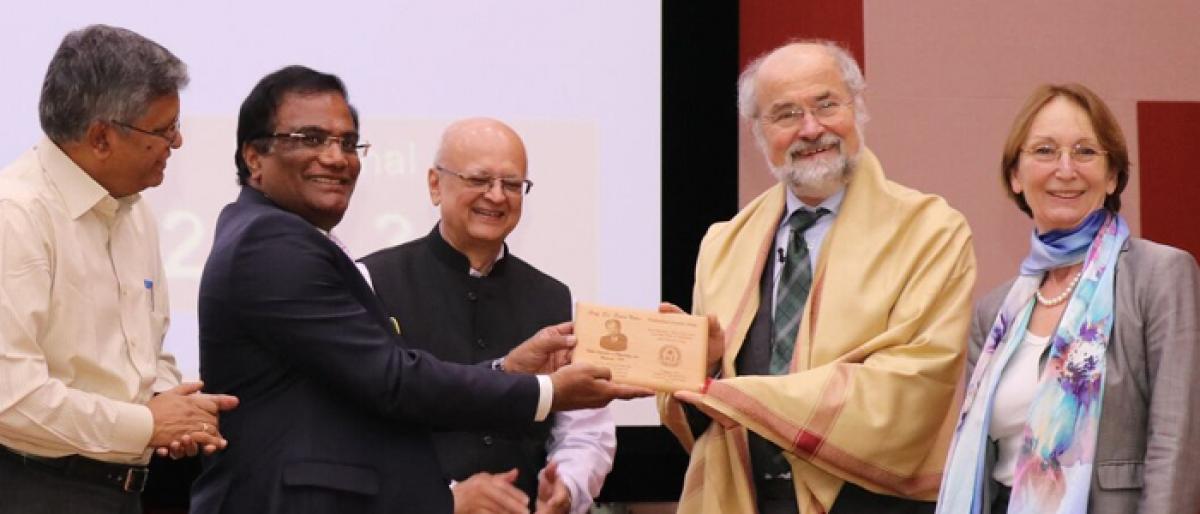Live
- MUDA scam: ED's findings against CM Siddaramaiah escalate political tensions
- Police arrest notorious blackmailer targeting young women
- MLA seeks elevated flyover to ease congestion
- TDP has an ace up its sleeve to breathe fresh air in TG unit
- Vaikuntha Dwara Darshan at Tirumala Temple Comes to a Close
- Civil Servants, Shoulder Shared Responsibilities!
- Hyd-Amaravati bypass bridge works to be completed by April
- Delhi polls: Women voters top agenda of all 3 parties
- Activities launched as part of 12-month action plan
- Rousing welcome for Amit Shah
Just In

Nobel Laureate and Director of the Max Planck Institute for Biophysical Chemistry, Germany, Prof Erwin Neher said that the discovering the ‘Patch Clamp Technique’ (PCT) helped in the screening and safety evaluation of drugs that are targeted to ion channels in a range of disorders.
Hyderabad: Nobel Laureate and Director of the Max Planck Institute for Biophysical Chemistry, Germany, Prof Erwin Neher said that the discovering the ‘Patch Clamp Technique’ (PCT) helped in the screening and safety evaluation of drugs that are targeted to ion channels in a range of disorders. He was speaking at the Hyderabad Lecturer Series (HLS) organised by the University of Hyderabad in association and support by the Insurance Regulatory Authority of India (IRDAI).
The Nobel Prize recipient in Physiology and Medicine in the year 1991, delivered the third lecture of the series on the topic ‘Ion Channels: Their discovery and their role in Biomedicine and Pharmacology’ at the School of Life Sciences in UoH, here on Thursday. Erwin Neher had dwelt in detail in his lecture discussing the earlier researches done in bio-electricity by scientists like Luigi Galvani, the pioneer of bioelectromagnetic, Santiago Ramon Y Cajal, Spanish neuroscientist and pathologist, and Julius Bernstein, a German Physiologist.
Outlining the importance of the PCT, he developed along with his colleagues, he said that it has revolutionised the study of ion channels, a kind of pore-forming proteins located in cell membranes that facilitate the passage of ions in and out of the cell, which has effect on the human physiology. The PCT allows the measurement of incredibly small electrical currents (amounting to a picoampere) that pass through a single ion channel, in the screening and safety evaluation of drugs that are targeted, to ion channels in a range of disorders. They include pain, epilepsy, depression, stroke, bipolar disorder, arrhythmia, hypertension, autoimmune disorders, cystic fibrosis and diabetes.
Further, elaborating on the ion channels and the concepts around them, such as the involvement of ion channels in conducting tasks in different cell types like the nerve cell, kidney cells, lymphocytes etc., This has become an area of interest for the pharma industry, in ion channels for drug discovery. He also explained the role of ion channels in heat and cold sensation, the diseases caused due to defect in ion channels, channelopathies in Cardiology and the importance of PCT in all these aspects. Later, he answered questions related to ion channels and their implications in the field from experts and students present at the venue.
Earlier, Prof Appa Rao Podile, Vice-Chancellor, UoH welcomed Prof Neher and his wife Dr Eva Maria Neher, who is a biochemistry scientist. He thanked Prof Mrutyunjay Saur, Director, School of Biotechnology, Kalinga Institute of Industrial Technology, for his efforts in making the event successful.

© 2025 Hyderabad Media House Limited/The Hans India. All rights reserved. Powered by hocalwire.com







